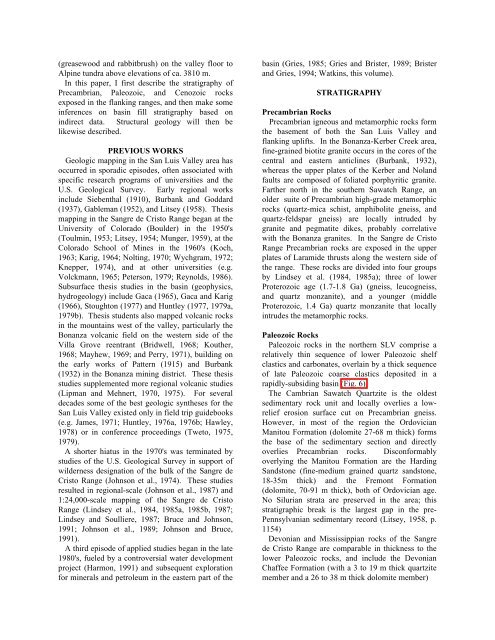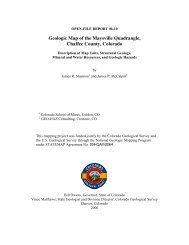general geology of the northern san luis valley, colorado
general geology of the northern san luis valley, colorado
general geology of the northern san luis valley, colorado
Create successful ePaper yourself
Turn your PDF publications into a flip-book with our unique Google optimized e-Paper software.
(greasewood and rabbitbrush) on <strong>the</strong> <strong>valley</strong> floor to<br />
Alpine tundra above elevations <strong>of</strong> ca. 3810 m.<br />
In this paper, I first describe <strong>the</strong> stratigraphy <strong>of</strong><br />
Precambrian, Paleozoic, and Cenozoic rocks<br />
exposed in <strong>the</strong> flanking ranges, and <strong>the</strong>n make some<br />
inferences on basin fill stratigraphy based on<br />
indirect data. Structural <strong>geology</strong> will <strong>the</strong>n be<br />
likewise described.<br />
PREVIOUS WORKS<br />
Geologic mapping in <strong>the</strong> San Luis Valley area has<br />
occurred in sporadic episodes, <strong>of</strong>ten associated with<br />
specific research programs <strong>of</strong> universities and <strong>the</strong><br />
U.S. Geological Survey. Early regional works<br />
include Siebenthal (1910), Burbank and Goddard<br />
(1937), Gableman (1952), and Litsey (1958). Thesis<br />
mapping in <strong>the</strong> Sangre de Cristo Range began at <strong>the</strong><br />
University <strong>of</strong> Colorado (Boulder) in <strong>the</strong> 1950's<br />
(Toulmin, 1953; Litsey, 1954; Munger, 1959), at <strong>the</strong><br />
Colorado School <strong>of</strong> Mines in <strong>the</strong> 1960's (Koch,<br />
1963; Karig, 1964; Nolting, 1970; Wychgram, 1972;<br />
Knepper, 1974), and at o<strong>the</strong>r universities (e.g.<br />
Volckmann, 1965; Peterson, 1979; Reynolds, 1986).<br />
Subsurface <strong>the</strong>sis studies in <strong>the</strong> basin (geophysics,<br />
hydro<strong>geology</strong>) include Gaca (1965), Gaca and Karig<br />
(1966), Stoughton (1977) and Huntley (1977, 1979a,<br />
1979b). Thesis students also mapped volcanic rocks<br />
in <strong>the</strong> mountains west <strong>of</strong> <strong>the</strong> <strong>valley</strong>, particularly <strong>the</strong><br />
Bonanza volcanic field on <strong>the</strong> western side <strong>of</strong> <strong>the</strong><br />
Villa Grove reentrant (Bridwell, 1968; Kou<strong>the</strong>r,<br />
1968; Mayhew, 1969; and Perry, 1971), building on<br />
<strong>the</strong> early works <strong>of</strong> Pattern (1915) and Burbank<br />
(1932) in <strong>the</strong> Bonanza mining district. These <strong>the</strong>sis<br />
studies supplemented more regional volcanic studies<br />
(Lipman and Mehnert, 1970, 1975). For several<br />
decades some <strong>of</strong> <strong>the</strong> best geologic syn<strong>the</strong>ses for <strong>the</strong><br />
San Luis Valley existed only in field trip guidebooks<br />
(e.g. James, 1971; Huntley, 1976a, 1976b; Hawley,<br />
1978) or in conference proceedings (Tweto, 1975,<br />
1979).<br />
A shorter hiatus in <strong>the</strong> 1970's was terminated by<br />
studies <strong>of</strong> <strong>the</strong> U.S. Geological Survey in support <strong>of</strong><br />
wilderness designation <strong>of</strong> <strong>the</strong> bulk <strong>of</strong> <strong>the</strong> Sangre de<br />
Cristo Range (Johnson et al., 1974). These studies<br />
resulted in regional-scale (Johnson et al., 1987) and<br />
1:24,000-scale mapping <strong>of</strong> <strong>the</strong> Sangre de Cristo<br />
Range (Lindsey et al., 1984, 1985a, 1985b, 1987;<br />
Lindsey and Soulliere, 1987; Bruce and Johnson,<br />
1991; Johnson et al., 1989; Johnson and Bruce,<br />
1991).<br />
A third episode <strong>of</strong> applied studies began in <strong>the</strong> late<br />
1980's, fueled by a controversial water development<br />
project (Harmon, 1991) and subsequent exploration<br />
for minerals and petroleum in <strong>the</strong> eastern part <strong>of</strong> <strong>the</strong><br />
basin (Gries, 1985; Gries and Brister, 1989; Brister<br />
and Gries, 1994; Watkins, this volume).<br />
STRATIGRAPHY<br />
Precambrian Rocks<br />
Precambrian igneous and metamorphic rocks form<br />
<strong>the</strong> basement <strong>of</strong> both <strong>the</strong> San Luis Valley and<br />
flanking uplifts. In <strong>the</strong> Bonanza-Kerber Creek area,<br />
fine-grained biotite granite occurs in <strong>the</strong> cores <strong>of</strong> <strong>the</strong><br />
central and eastern anticlines (Burbank, 1932),<br />
whereas <strong>the</strong> upper plates <strong>of</strong> <strong>the</strong> Kerber and Noland<br />
faults are composed <strong>of</strong> foliated porphyritic granite.<br />
Far<strong>the</strong>r north in <strong>the</strong> sou<strong>the</strong>rn Sawatch Range, an<br />
older suite <strong>of</strong> Precambrian high-grade metamorphic<br />
rocks (quartz-mica schist, amphibolite gneiss, and<br />
quartz-feldspar gneiss) are locally intruded by<br />
granite and pegmatite dikes, probably correlative<br />
with <strong>the</strong> Bonanza granites. In <strong>the</strong> Sangre de Cristo<br />
Range Precambrian rocks are exposed in <strong>the</strong> upper<br />
plates <strong>of</strong> Laramide thrusts along <strong>the</strong> western side <strong>of</strong><br />
<strong>the</strong> range. These rocks are divided into four groups<br />
by Lindsey et al. (1984, 1985a); three <strong>of</strong> lower<br />
Proterozoic age (1.7-1.8 Ga) (gneiss, leucogneiss,<br />
and quartz monzanite), and a younger (middle<br />
Proterozoic, 1.4 Ga) quartz monzanite that locally<br />
intrudes <strong>the</strong> metamorphic rocks.<br />
Paleozoic Rocks<br />
Paleozoic rocks in <strong>the</strong> nor<strong>the</strong>rn SLV comprise a<br />
relatively thin sequence <strong>of</strong> lower Paleozoic shelf<br />
clastics and carbonates, overlain by a thick sequence<br />
<strong>of</strong> late Paleozoic coarse clastics deposited in a<br />
rapidly-subsiding basin (Fig. 6).<br />
The Cambrian Sawatch Quartzite is <strong>the</strong> oldest<br />
sedimentary rock unit and locally overlies a lowrelief<br />
erosion surface cut on Precambrian gneiss.<br />
However, in most <strong>of</strong> <strong>the</strong> region <strong>the</strong> Ordovician<br />
Manitou Formation (dolomite 27-68 m thick) forms<br />
<strong>the</strong> base <strong>of</strong> <strong>the</strong> sedimentary section and directly<br />
overlies Precambrian rocks. Disconformably<br />
overlying <strong>the</strong> Manitou Formation are <strong>the</strong> Harding<br />
Sandstone (fine-medium grained quartz <strong>san</strong>dstone,<br />
18-35m thick) and <strong>the</strong> Fremont Formation<br />
(dolomite, 70-91 m thick), both <strong>of</strong> Ordovician age.<br />
No Silurian strata are preserved in <strong>the</strong> area; this<br />
stratigraphic break is <strong>the</strong> largest gap in <strong>the</strong> pre-<br />
Pennsylvanian sedimentary record (Litsey, 1958, p.<br />
1154)<br />
Devonian and Mississippian rocks <strong>of</strong> <strong>the</strong> Sangre<br />
de Cristo Range are comparable in thickness to <strong>the</strong><br />
lower Paleozoic rocks, and include <strong>the</strong> Devonian<br />
Chaffee Formation (with a 3 to 19 m thick quartzite<br />
member and a 26 to 38 m thick dolomite member)




